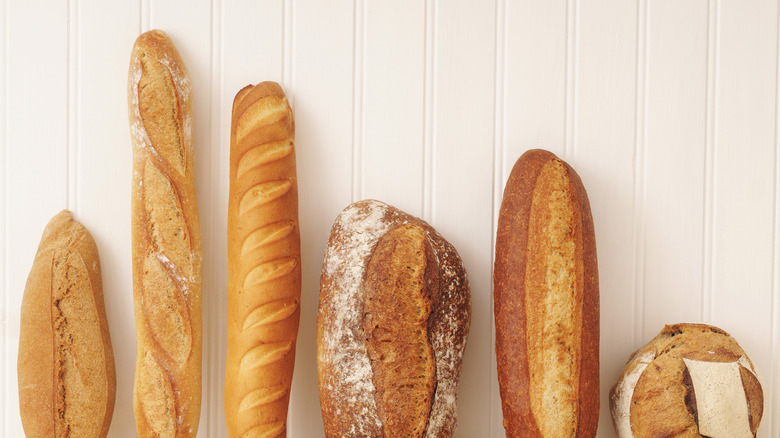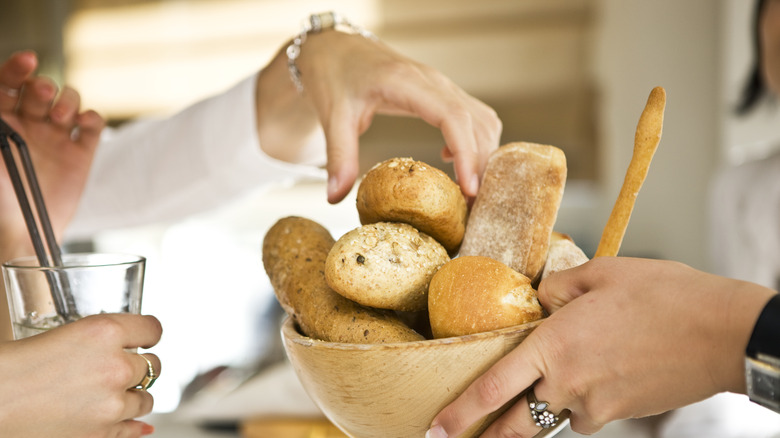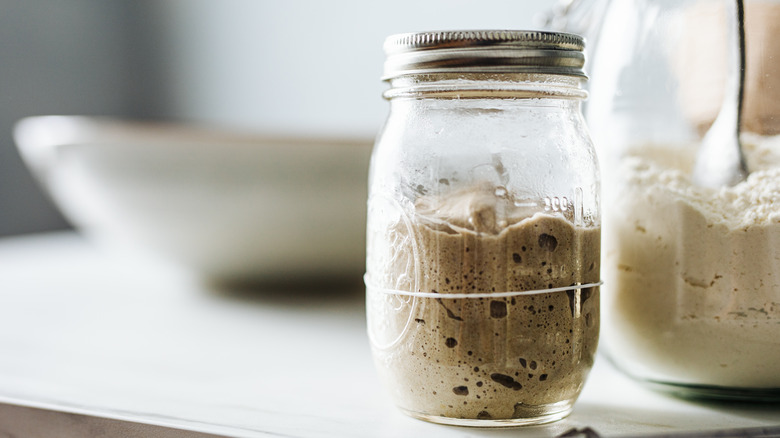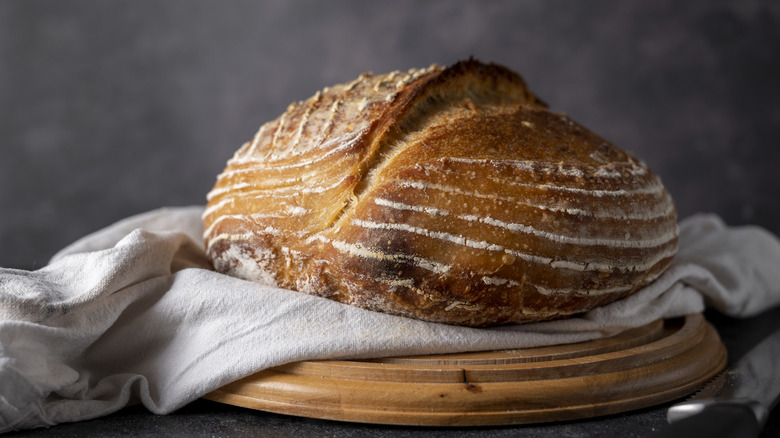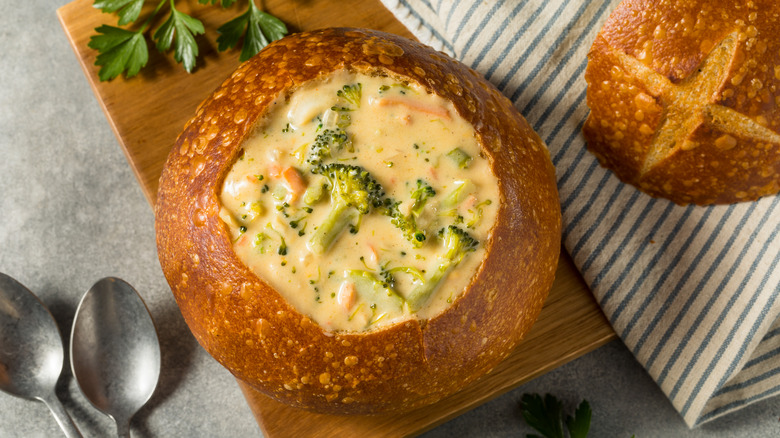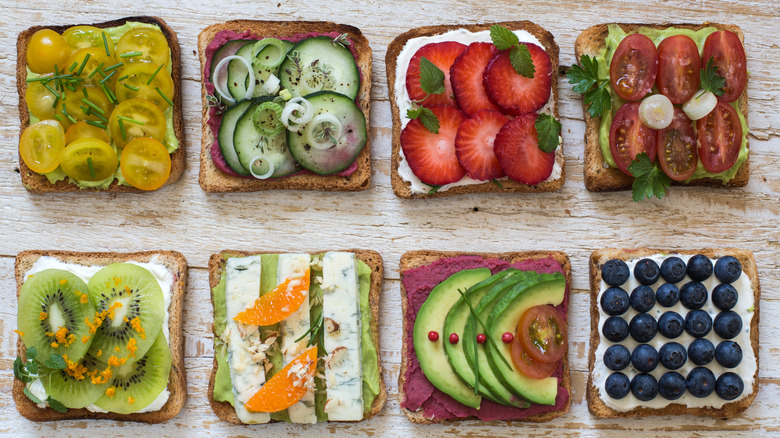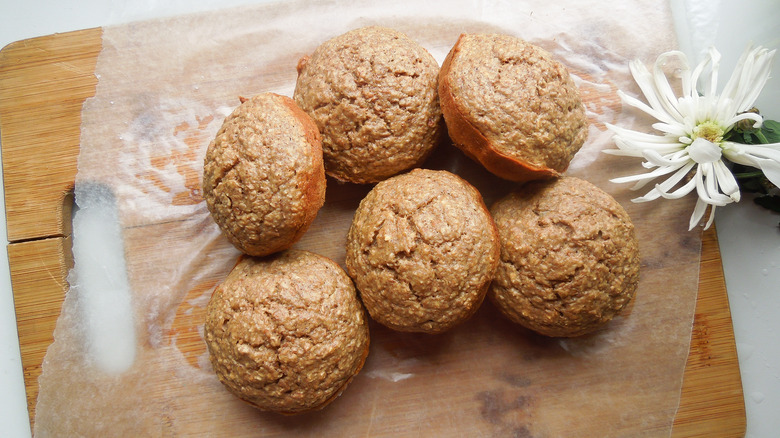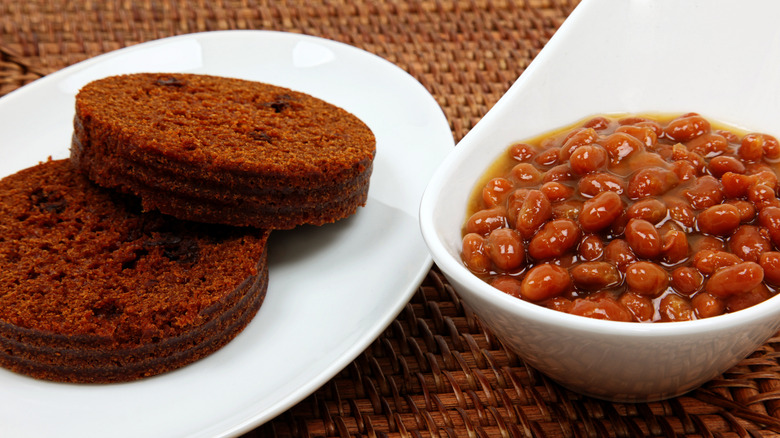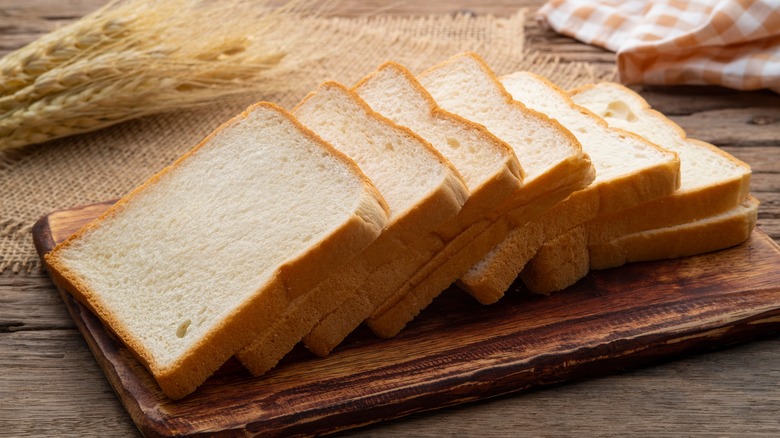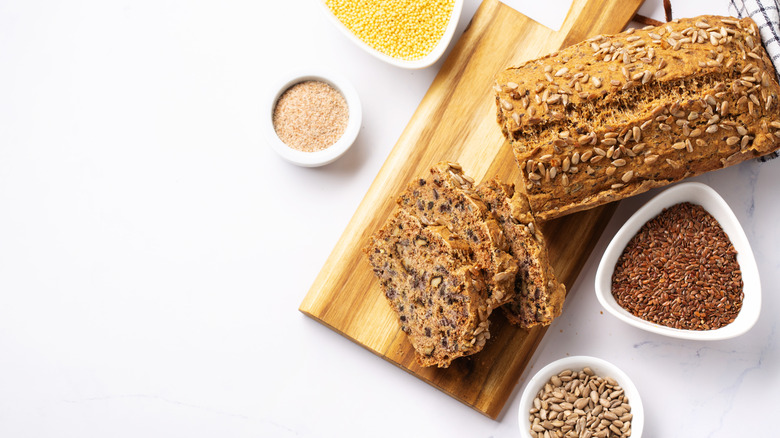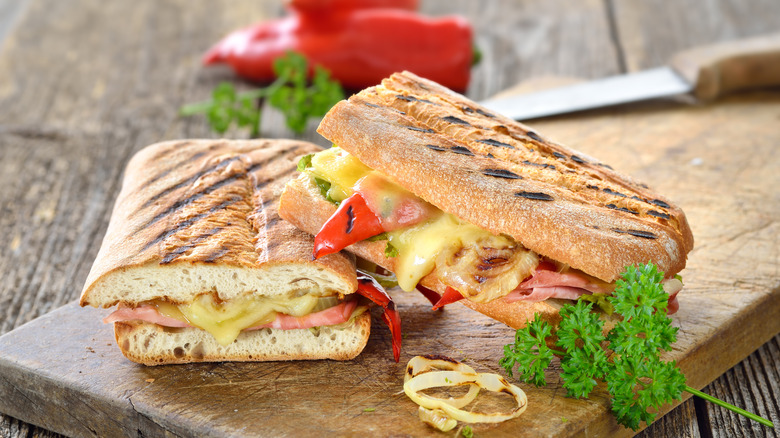Once-Popular Bread Trends That Need To Make A Comeback
Bread is one of the most widely consumed foods in the world. While the exact origins of breadmaking are long buried, scientists have uncovered evidence of ovens and ancient crumbs dating back 14,000 years in present-day Jordan. Yeasted bread appeared around 1,350 B.C.E. in Egypt, and the rest, as they say, is history. Today, Americans eat about 47.3 pounds of bread each year per capita, and spent about $24.2 billion on it in 2022.
Around the world, bread is a vital and affordable staple. From roti in South Asia to injera in East Africa and baguettes in Europe, it forms a foundational part of daily diets. It has come to symbolize hospitality, abundance, and communion, and play a prominent role in religious texts.
Given its lengthy and pervasive presence in our culture, it's no surprise that bread has undergone many iterations over the millennia. Some trends, such as flatbread, sourdough, and sandwich bread, seem here to stay. Others have sadly faded in popularity since their heydays. Tastes change and culinary traditions evolve, but there are plenty of innovations that didn't have the staying power they deserve. Keep reading to discover bread trends from over the years that deserve to make a comeback.
Free bread baskets
There was a time in the not-too-distant past when you could go to a restaurant with your family and stuff yourself with free bread before the server even took your order. As if by magic, a basket would appear as soon as you sat down, and keep you satiated until the entrees arrived. Kids could occupy themselves by arguing over which sibling got which bread rolls, and parents could breathe a sigh of relief that they wouldn't have to order as much food as they'd expected.
These days, however, the bread basket is an endangered species. When they do appear, it's usually in the form of a line of text on the menu next to a two-digit price. Words like "whipped butter" and "stone ground" are often included to justify the cost, but most of us would take free, stale dinner rolls over $10 mini brioche any day.
The reason restaurants started serving free bread was because it kept customers occupied and fed while they waited for their meals. But good bread is expensive, and in the low-margin restaurant industry, every penny counts. Plus, given how much free bread goes uneaten, this expense is doubly wasteful. Since the baking craze of the pandemic, customers also have a new appreciation for quality bread and restaurants are all too eager to capitalize on it. Still, it's hard not to pine for those glorious days when you could get enough bread to feed a hungry table for precisely zero dollars.
Homemade sourdough
When future generations look back on 2020, a few things will stand out. Lockdown mandates, social distancing, endless Zoom meetings, and, probably, sourdough. People were stuck at home, desperate to be creative and adventurous in risk-free ways, and when a rush on baking supplies led to a yeast shortage, naturally leavened sourdough was the obvious answer. By the end of March, Instagram feeds were full of crusty loaves, YouTube tutorials proliferated, bakeries were selling starter kits, and columnists took to prominent media outlets to explain why they were resisting the peer pressure to join the fray.
It all happened so quickly and in such isolated circumstances that a fall from grace was inevitable. By summer, the number of new YouTube videos featuring sourdough in the title plummeted, and despite minor upticks here and there, including at the end of 2020 when there was another surge in COVID-19 hospitalizations, the downward spiral continued. By 2022, cooking fatigue set in, and consumers were expressing a desire for convenience, a sentiment in direct opposition to the hands-on, hours-long process of making sourdough, and a year later, social media conversations about the bread fell 22% from 2022.
For those with a full-time job outside the home, making naturally leavened bread on a regular basis is not feasible. But if you have the time, the thrill and unpredictability of making sourdough is worth the 2020 hype–-even if people aren't talking about it anymore.
Artisanal bread
After decades of industrialized breadmaking, Americans fell in love with artisanal bread in the 1980s. Pioneering bakeries such as Steve Sullivan's Acme Bread Company in Berkeley, California went back to basics with wood-fired ovens and natural leavening, showing Americans just what they had been missing when the industry went all-in on mass-produced, pillow-soft sliced bread. Consumers started buying their bread from bakeries instead of grocery stores, and European-style crusty bread became mainstream. For people who had only ever eaten Wonder Bread, freshly-made loaves made on-site with the highest quality ingredients were a revelation. Words like "focaccia," "levain," and "pain de mie" were no longer owned by the French, but shared by the Bay Area bakers who brought them to American eaters. Bakeries from California to D.C. had lines of eager customers snaking out their front doors, and new bakers were inspired to open businesses.
As low-carb and gluten-free trends took hold in the 2000s and large-scale manufacturers started churning out their own versions of seeded boules and crunchy baguettes, local bakeries lost the upper hand. Although you can still find small businesses producing artisanal loaves throughout the country, they are no longer the darling of the food industry the way they were in the '80s and '90s, and consumers don't always have the financial leeway to drop $8 on a loaf of sourdough. For anyone who's eaten a freshly-baked slice of expertly created bread, however, it's hard not to long for another nationwide boom in artisanal carbs.
Bread bowls
If you were a frequenter of restaurants in the '80s or '90s, you probably saw bread bowls on the menu fairly often. Round, hollowed-out loaves filled with liquid, they offered a fresh spin on the age-old soup and bread pairing. Although the invention supposedly dates back to a 15th-century Irish nobleman who was trying to impress an English duke, it gained traction in San Francisco in the 1980s when someone had the stroke of genius to pair the city's famous sourdough loaves with New England chowder. A decade later, restaurants across the country followed suit. Bread filled with curry, chicken cacciatore, and any other dish with enough moisture to need a bowl but not enough to soak through the bread was subject to the trend.
The low-carb trend in the early 2000s turned it into a quaint throwback to the '80s and '90s. Quiznos launched its own version in 2006, and Panera put its stamp on the retro calorie bonanza in 2018 with a double bread bowl, but few restaurants joined them. If you visit San Francisco, someone will probably direct you toward the Boudin Bakery Cafe where they still churn out the original sourdough and clam chowder combo. Outside of San Francisco, however, we're still waiting for the fine dining world to remember what a knockout idea bread bowls are. Making carbs not only a delicious part of the meal but also a structurally integral is sheer culinary genius.
Open-faced sandwiches
Open-faced sandwiches have been around in Denmark since the Middle Ages. Called smørrebrød, they grew in popularity in the 19th and 20th centuries as an easy, adaptable lunch, and are now a frequent feature on the menus of gourmet restaurants. They are traditionally made of a slice of rye bread topped with combinations of mayonnaise, horseradish, pickled herring, cheese, roast beef, fried onions, and boiled eggs. Other countries including Austria, Estonia, and Czechia, have produced similar open-faced sandwiches for generations, while France's croque monsieur is a world-renowned variation.
The obsession with open-faced sandwiches kicked off in the U.S. in a big way when Café Gitane in New York started selling shamelessly photogenic slices of avocado toast in 2006. Gwyneth Paltrow included a recipe in her 2013 cookbook, and copycat versions surfaced across the internet. By 2015, the trend had exploded. Avocado toast became inextricably linked to the millennial generation, usually as a way for older generations to criticize their financial responsibility.
The negative cultural symbolism ascribed to open-faced sandwiches overshadowed their merits and possibly even led to their downturn in popularity in the U.S. In 2023 alone, social media conversations about open-faced sandwiches had fallen by 62% from 2022. But these sandwiches deserve to be appreciated on their culinary merits. They are infinitely adaptable, visually appealing, and for anyone trying to avoid carbs, have half the bread of a normal sandwich without feeling remotely like diet food. What's not to love?
Bran
Americans were obsessed with cholesterol in the 1980s after a series of government dietary guidelines warned them of heart disease. Low-fat diets were a natural (though ill-advised) response, but one of the more unlikely stars of the movement was wheat bran. Dubious medical claims asserted that it could lower cholesterol, and by the late '80s, the long-neglected outer husk of wholegrains was everywhere. Bakeries across the country were selling out of bran muffins, Quaker Oats went from selling one million pounds of oat bran hot cereal in 1987 to 20 million pounds in 1989, bran-themed cookbooks sold millions of copies, and grocery store shelves overflowed with new products containing the miracle ingredient.
Then, a Harvard study put an end to the hysteria. Published in 1990, it revealed that there was no significant difference between cholesterol levels in people who ate bran compared to people who ate white flour. The national appetite for bran plummeted, and it's kept a low profile ever since.
Admittedly, it might not be everyone's favorite ingredient. It doesn't create light, fluffy baked goods the way white flour does, and it has a distinctive nutty flavor that isn't for everyone. But it has a host of nutritional benefits, especially fiber and protein, that make it worth including in your diet. If you're not sure where to begin, look no further than these spiced bran muffins. Even if you're skeptical, our recipe might just make you a fan.
Boston brown bread
Making bread in a can might not sound like a tradition worth reviving, but Boston brown bread defies expectations. Known simply as brown bread in New England, it's an unyeasted bread made with a mixture of cornmeal, rye flour, molasses, baking soda, and buttermilk, and steamed in a can on the stove. Some historians believe it dates back to the Puritans in the 1600s who did not regularly have stoves or easy access to wheat. The sweet, soft loaves were a welcome contrast to the dense, unsteamed alternatives, and they became a popular staple. Other historians claim that it didn't appear until the 19th century. Either way, this delicious combination of bread pudding and quick bread was eventually sold in cans at grocery stores, but faded over time, especially in the latter half of the 20th century. Traditionally served with baked beans, it's the kind of dish that some New Englanders are fiercely loyal to, but to which many outside the Northeast are oblivious.
There is no reason why Boston brown bread should stay neglected or regional. It's easy to make, delicious to eat, and distinctive from most of the go-to quick breads that home bakers make on a regular basis. The strong flavors of rye flour and molasses complement each other, and the cornmeal adds a delicious layer of sweetness. And besides the flavor, steaming a cake on your stove top is a novelty you won't want to miss.
White bread
White bread has become a synonym for mediocrity, but when it first flooded the market in the early 20th century, it was revolutionary. For centuries, it had been a status symbol for elites who could afford refined wheat flour. During the Industrial Revolution, however, a system was invented to streamline the separation of the endosperm from the wheat germ and bran, allowing white bread to be produced cheaply on a grand scale. Wonder Bread took things to the next level by bleaching its flour and adding sugar and nutrients, and by the 1950s, nearly 30% of Americans' daily caloric intake came from white bread, according to The Believer.
However, the beloved pantry staple took a hit in the '60s when the countercultural revolution targeted industrialized food. In the 1970s, the Federal Trade Commission accused the maker of Wonder Bread of making deceptive nutritional claims. Forty years later, sales of whole grain bread surpassed sales of white bread for the first time, a trend that, as of 2020 data, continues.
There's no dodging the fact that white flour is less nutritious than whole-grain flour. It's severely lacking in fiber and vitamins, and it consequently has a high glycemic index. But it also provides a texture to baked goods that cannot be achieved with whole grains. Baguettes, croissants, and ciabattas do not have the same lightness or flavor without it, and a freshly baked loaf of white bread should be celebrated, not demonized.
Bread made with so-called ancient grains
There is no official definition of what an ancient grain is exactly, but consumers went crazy for them in the early 2010s. Spelt, quinoa, buckwheat, and millet became buzzwords that brands emblazoned on boxes of cereal and bags of bread, extolling their never-ending health benefits. The concept behind ancient grains is that they are the antithesis of processed foods. Whole, unrefined, and supposedly farmed in the same way for millennia, they were the logical destination for the backlash against processed foods and the craze over hunter-gatherer diets at the time. What could be less processed than grains eaten by pharaohs and enshrined in the Old Testament?
The obsession hit a fever pitch around 2014 when sales of ancient grains experienced a 50% leap across all food categories, per the BBC. Cheerios released its own ancient grains option in 2015, and from there, the term was so mainstream that, like the equally undefined "superfood" category, it ceased to wield power. When every brand is wedging ancient grains into its products, it's hard to feel like you're on the cutting edge of dietary science.
That said, so-called ancient grains offer tremendous variety and health benefits. While it's overly simplistic to group them together and profess them to be a one-way ticket to perpetual health, many of them are full of protein, omega-3 fatty acids, and fiber. Using wholegrain spelt or kamut flour instead of refined white flour benefits your health, and brings new flavors into your baking.
Paninis
America's love affair with Italian food runs deep. Pizza, spaghetti, espresso–you name it, we love it. In the early 2000s, another deliciously carb-filled item began appearing on American menus: the panini (or panino, if you want to be linguistically correct). Although it is a variation of a sandwich that has the characteristic toasted lines of a panini press, this food item took the lunchtime scene by storm. Upscale cafés served gourmet versions oozing with cheese to celebrity diners, and people who had once despaired at the idea of having a sandwich for lunch embraced them with open arms. Even McDonald's joined the frenzy, offering its take on the Italian trend in 2004. For businesses, especially deli counters, paninis were a cost-effective way to upgrade their menu and appeal to customers looking for something more high-end than a sandwich. Instead of needing new cooking equipment, they only needed a panini press.
By the end of the decade, they were so mainstream that you could buy them at Starbucks and Subway. They were no longer a novelty but a familiar fixture, and their distinctive characteristics were slowly diluted until you could hardly tell the difference between a true Italian panino and a run-of-the-mill toasted sandwich. And yet, anyone who has tasted a perfectly executed, freshly-toasted panini on ciabatta oozing with melted mozzarella knows that there is nothing quite like it, and it's high time we fell back in love with this Italian delicacy.
